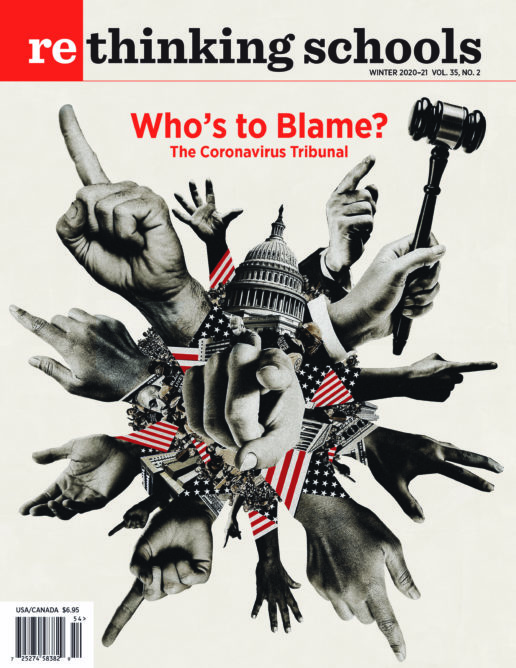Our picks for books, videos, websites, and other social justice resources — Winter 2020–21
***
Picture Books
Unspeakable: The Tulsa Race Massacre
By Carole Boston Weatherford
Illustrated by Floyd Cooper
(Carolrhoda Books, 2021)
32 pp.
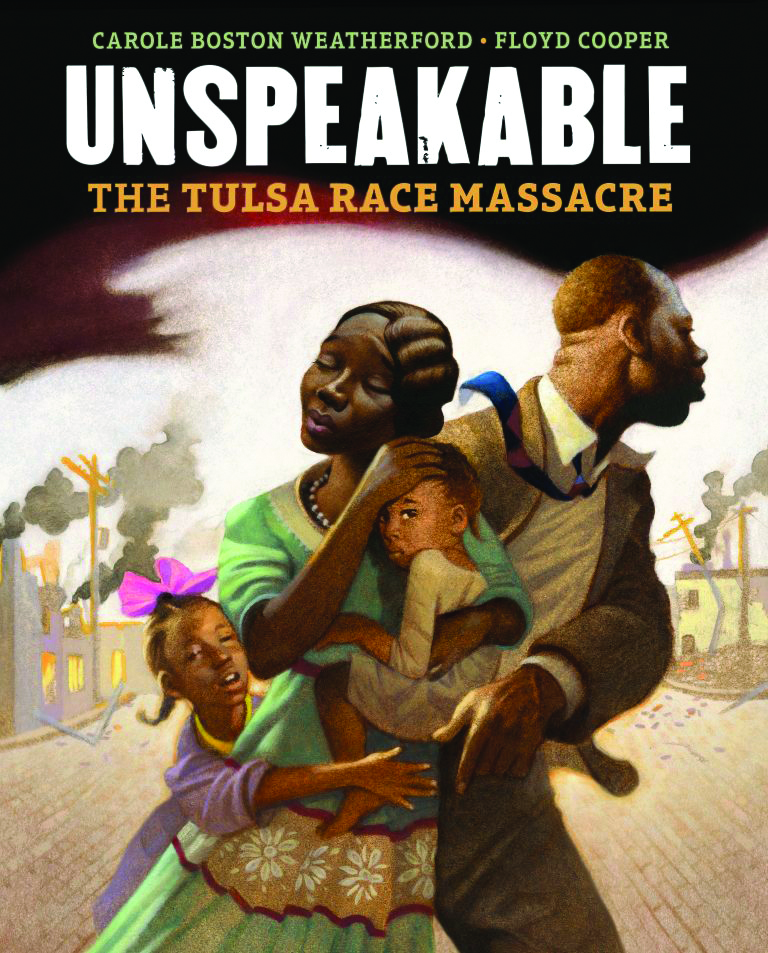
Written as a “Once upon a time . . .” story in a picture book format about the thriving Black community of Greenwood, Unspeakable centers on the history before the 1921 massacre. Children learn about the Black businesses, libraries, schools (“where some say Black children got a better education than whites”), bus system, auto shop, hospital, newspapers, movie theaters, hotel, and post office. Floyd Cooper’s stunning illustrations bring Black Wall Street to life. Then comes the white terrorists — “unchecked, in some cases deputized, by the police.” Sensitive to young readers without hiding the truth, author Carole Boston Weatherford continues the use of “Once upon a time . . .” to explain the tragedy that was designed by police and city officials “to destroy the nation’s wealthiest Black community.” The book closes with images of Tulsa’s Reconciliation Park. Recommended for grades 3+.
No Voice Too Small: Fourteen Young Americans Making History
Edited by Lindsay H. Metcalf,
Keila V. Dawson, and Jeanette Bradley
Illustrated by Jeanette Bradley
(Charlesbridge, 2020)
40 pp.
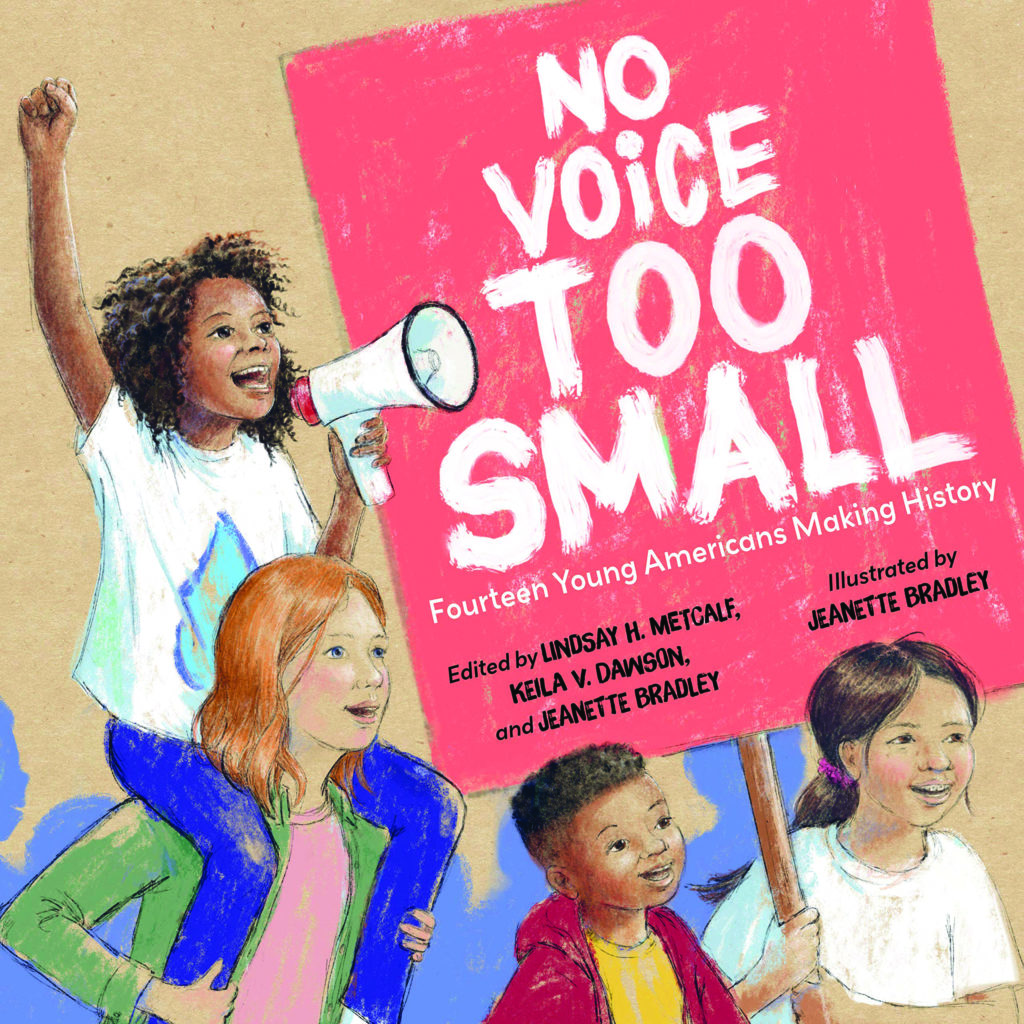
Now it is our time.
Our new generation
will not give up
this sacred struggle.
It is for our lives,
for all of our relations.
These ending lines from the poem “Jasilyn Charger: Water Protector” by Joseph Bruchac in No Voice Too Small offer a glimpse into the rich simplicity of a book brimming with examples of young people’s activism, beautiful poetry, and teaching possibilities. In this picture book collection, readers are introduced to 14 young people using a variety of activism strategies to make the world more just, including Ziad Ahmed, Samirah Horton, Jazz Jennings, Judy Adams, Adora Svitak, Viridiana Sanchez Santos, and Marley Dias. Each biographical profile consists of a poem accompanied by a paragraph about the young person’s activism, a portrait, and a related activism tip. The biographical poems are written by poets who share some aspect of the young activist’s identity; poets’ bios and connections are included at the back of the book. The book’s YouTube channel includes video resources such as poetry readings and writing lessons by contributing poets such as Janet Wong, G. Neri, Charles Waters, and Nikki Grimes.
***
Curriculum
The Selected Works of Audre Lorde
Edited by Roxane Gay
(W. W. Norton & Company, 2020)
367 pp.

“Lorde was the first writer who actively demonstrated for me that a writer could be intensely concerned with the inner and outer lives of Black queer women that our experiences could be the center instead of relegated to the periphery.” This comes from Roxane Gay’s introduction to the new collection of Audre Lorde’s poems and essays, and offers some of the richness that Lorde’s works provide teachers. Lorde’s writing was “intersectional” long before that became a buzzword, because she wrote openly and honestly about her own life, which she lived at the intersections of woman, Black, queer, scholar, poet, activist, and more. In the poem, “Conclusion,” Lorde writes,
I believe in love as I believe in our children
But I was born Black and without illusions
and my vision
which differs from yours
is clear
although sometimes restricted.
We might use this poem to ask our students, “What is your vision? And what makes it different from mine? Or from that of your peers? What does it allow you to see clearly?” Bringing Lorde’s autobiographical works into our curriculum can invite our students to bring their whole selves with them into our classrooms, too.
The Rebellious Life of Mrs. Rosa Parks — Young Readers Edition
By Jeanne Theoharis; Adapted by
Brandy Colbert and Jeanne Theoharis
(Beacon, 2021)
283 pp.
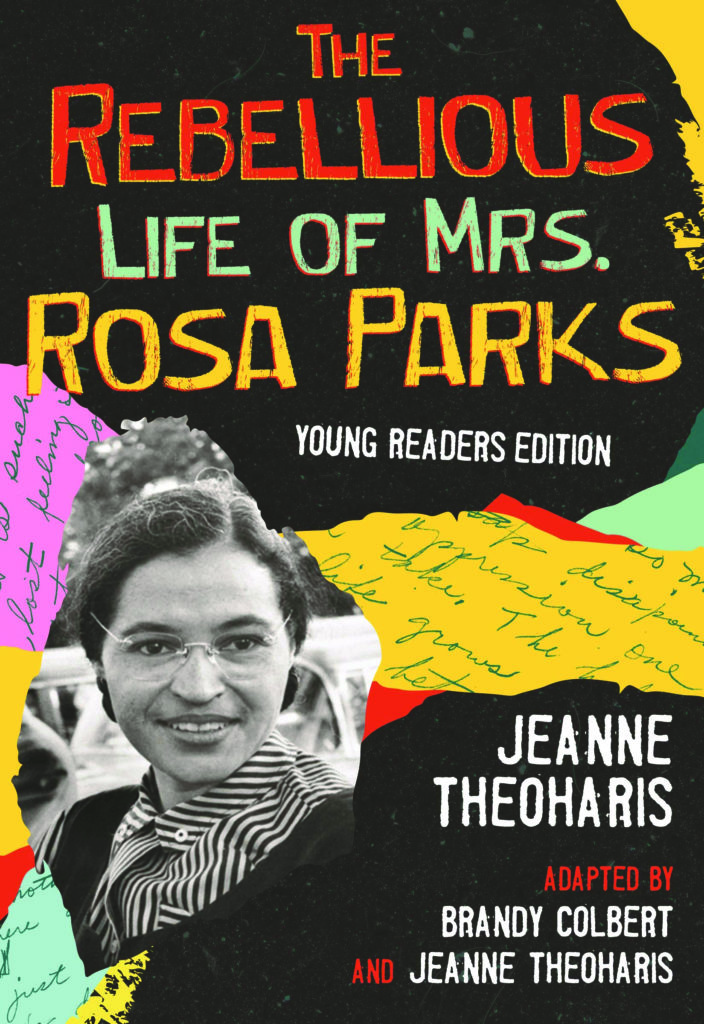
Rosa Parks is one of the most famous women in U.S. history. And yet all that most young people know about her is that “she refused to give up her seat on the bus.” She did. Courageously. Heroically. And it sparked a citywide bus boycott that contributed to a mass movement for civil rights. But, as this new adaptation shows so movingly and with such intricate detail, Rosa Parks should not be “trapped on the bus.” This is a story about the real, the full Rosa Parks — the Rosa Parks who was a lifelong activist and tireless organizer who fought against housing segregation, against police brutality, in support of women who stood up to their male abusers, and for an end to apartheid in South Africa. Young people know about Parks’ stand on that bus in Montgomery, Alabama, but do they know that she lived and worked and organized for justice for more than half her life in the North, in Detroit? In story after story, Jeanne Theoharis and collaborator Brandy Colbert breathe life into the rebellious Mrs. Rosa Parks, a fighter for justice who will intrigue and inspire young people. And for all of us who want to teach honestly about Rosa Parks and the Civil Rights Movement, this is an essential resource.
A Graphic Biography of Paul Robeson
Art and text by Sharon Rudahl; edited by Paul Buhle and Lawrence Ware
(Rutgers University Press, 2020)
142 pp.

Paul Robeson was a towering figure in the 20th century. A brilliant scholar, athlete, singer, stage and film actor, activist, and revolutionary — and almost entirely erased from the curriculum, with a perfunctory sentence or two in U.S. history textbooks. This new graphic novel about Robeson’s life should be in every school library. It offers a fast-paced yet detailed overview of Robeson’s remarkable life. The illustrations and narrative are playful and lively, but never lose sight of how Robeson’s life was animated by fights against racism, fascism, and class oppression — and in favor of international solidarity of all kinds. Not surprisingly, Robeson was blacklisted and hauled before HUAC — the House Un-American Activities Committee: “Why did you not stay in Russia?” “Because my father was a slave, and my people died to build this country and I am going to stay here and have a part in it just like you. And no fascist-minded people will drive me from it. Is that clear?” This is the kind of defiance that can sing to our students.
***
Organizing/Activism
Black Lives Matter at School: An Uprising for Educational Justice
Edited by Denisha Jones and
Jesse Hagopian; foreword by Opal Tometi
(Haymarket Books, 2020)
297 pp.

This essential handbook offers a cornucopia of stories, strategies, campaigns, and lessons for making Black lives matter at school. Denisha Jones, early childhood educator and Sarah Lawrence College professor, and Seattle teacher and Rethinking Schools editor Jesse Hagopian are not distant editors picking and choosing readings from afar. They are immersed in the struggles they present here — and this intimate knowledge of issues, individuals, and organizations weaves through every selection in the book. This is the autobiography of a movement — with first-person accounts from Seattle, Philadelphia, Chicago, Los Angeles, New York City, Washington, D.C., and beyond; with stories from classrooms, schools, school districts, and unions; from high school, elementary, and early childhood educators, union activists, scholars, and students. During the book’s coming-out webinar in December, sponsored by Haymarket Books, contributor Brian Jones of the Schomburg Center for Research in Black Culture read from an interview Hagopian had conducted with Vermont student activist Noel Riby-Williams about students’ victorious campaign at Montpelier High School to raise the Black Lives Matter flag. The interview is included in the book. Riby-Williams describes the moment the flag was raised: “Every student of color that was there — whether they were in middle school or elementary school — were all able to help pull the flag up. So we got in a line and we all pulled it up together. That was really beautiful. Our little brothers were there. And as we tugged at the rope, I started crying. At that moment I felt like I was doing this for my little brothers. They’re Black young men, and it’s hard to be Black in this world. But that day was overall just beautiful.” Black Lives Matter at School portrays that beauty. No doubt, it is a struggle, but it can be a joyful one. This book offers a road map to join.
We Still Here: Pandemic, Policing, Protest, & Possibility
By Marc Lamont Hill; foreword by
Keeanga-Yamahtta Taylor
(Haymarket Books, 2020)
117 pp.
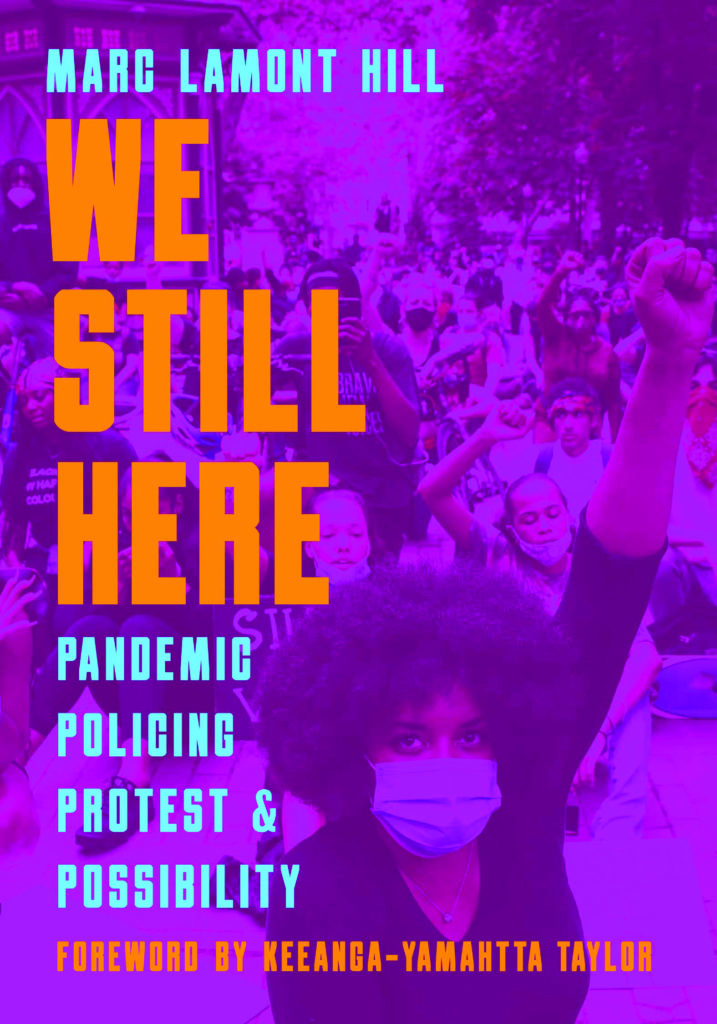
Marc Lamont Hill’s newest book is small and urgent. Focused on the racist roots of the 2020 pandemic and uprising, it is a book about right now, written right now. Hill writes, “It’s not enough just to recount the things that have happened in this crazy year of 2020. We must analyze the deeper conditions and structures that allowed 2020 to happen. . . . We must come to understand everything that brought us here.” Although a book of only 117 pages will not, of course, delve deeply into “everything that brought us here,” it is a kind of primer, surfacing the questions we should ask as we navigate the social realities of Hill’s subtitle: the pandemic, policing, and protest. We Still Here is actually a dialogue, a series of conversations between French activist Frank Barat and Hill, each neatly housed under provocative chapter titles like “How Shall We Die?,” “Preexisting Conditions,” and “Corona Capitalism.” These chapters, laid out as questions and answers, are high school student-friendly. One thought would be to ask students to compare Hill’s analysis of the uprising or racially disparate impact of the pandemic to an article on the same topic from the Washington Post or New York Times. Students might notice, for example, the way the idea of “comorbidities” invites a deeper understanding of the generational inheritances of white supremacy in the hands of Hill, while sitting inertly as a kind of accident of history on the pages of most mainstream media.
Time to Teach: A History of the Southern Civil Rights Movement
By Julian Bond
Edited by Pam Horowitz and Jeanne Theoharis; afterword by Vann Newkirk II
(Beacon Press, 2021)
356 pp.
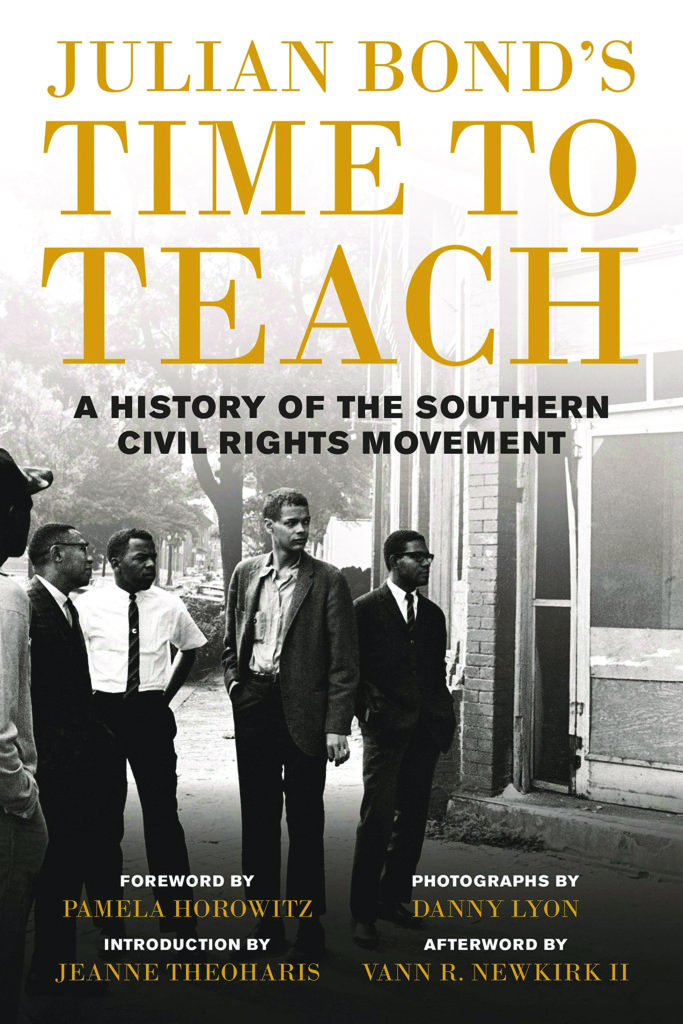
Everyone who took a course with SNCC veteran Julian Bond testifies to his depth of knowledge, storytelling, firsthand experience — and his wit. Bond transformed students’ understanding of the Civil Rights Movement, and as a result upended their perspectives on U.S. history and politics today. Thanks to Time to Teach, the rest of us can learn from the classes Bond taught for decades at the University of Virginia and American University. Historian Jeanne Theoharis was a student of Bond’s and co-edited this collection of his lectures, which he constantly revised based on new scholarship. Theoharis writes that Bond sought to have students “see the movement in its full complexity, to understand what it took — the strategy and the organizing, the many, many people who pushed it forward, and the many, many people who stood in its way — was necessary to understanding our own way forward.” The 22 chapters begin with the founding of the NAACP and carry the reader through the anti-Vietnam War and Black Power movements.
***
Art
Celebrate People’s History: The Poster Book of Resistance and Revolution (Second Edition)
Edited by Josh MacPhee
Forewords by Charlene Carruthers and Rebecca Solnit
(Feminist Press, 2020)
256 pp.

It’s easy to lose oneself in this rich collection of more than 100 posters edited by Justseeds Artists’ Cooperative member Josh MacPhee. The beautiful posters, representing a range of artists and events in U.S. and world history, were originally posted in public spaces to counter the “endless barrage of brightly colored advertisements and commercial window displays.” The 2010 edition included events such as the AIM occupation of Alcatraz, the Anti-Apartheid struggle, the Pueblo Revolt, Sacco and Vanzetti, the Battle of Blair Mountain, the Korean Peasants League, ACT UP Philadelphia, and dozens more. This 2020 second edition adds posters about “recent struggles around Arab Spring, Black Lives Matter, Idle No More, current immigration rights organizing, and more.” Many of the posters are also available at the Just Seeds website (justseeds.org/project/cph).
Reviewed by Bill Bigelow, Deborah Menkart, Ursula Wolfe-Rocca, and Elizabeth Barbian.

